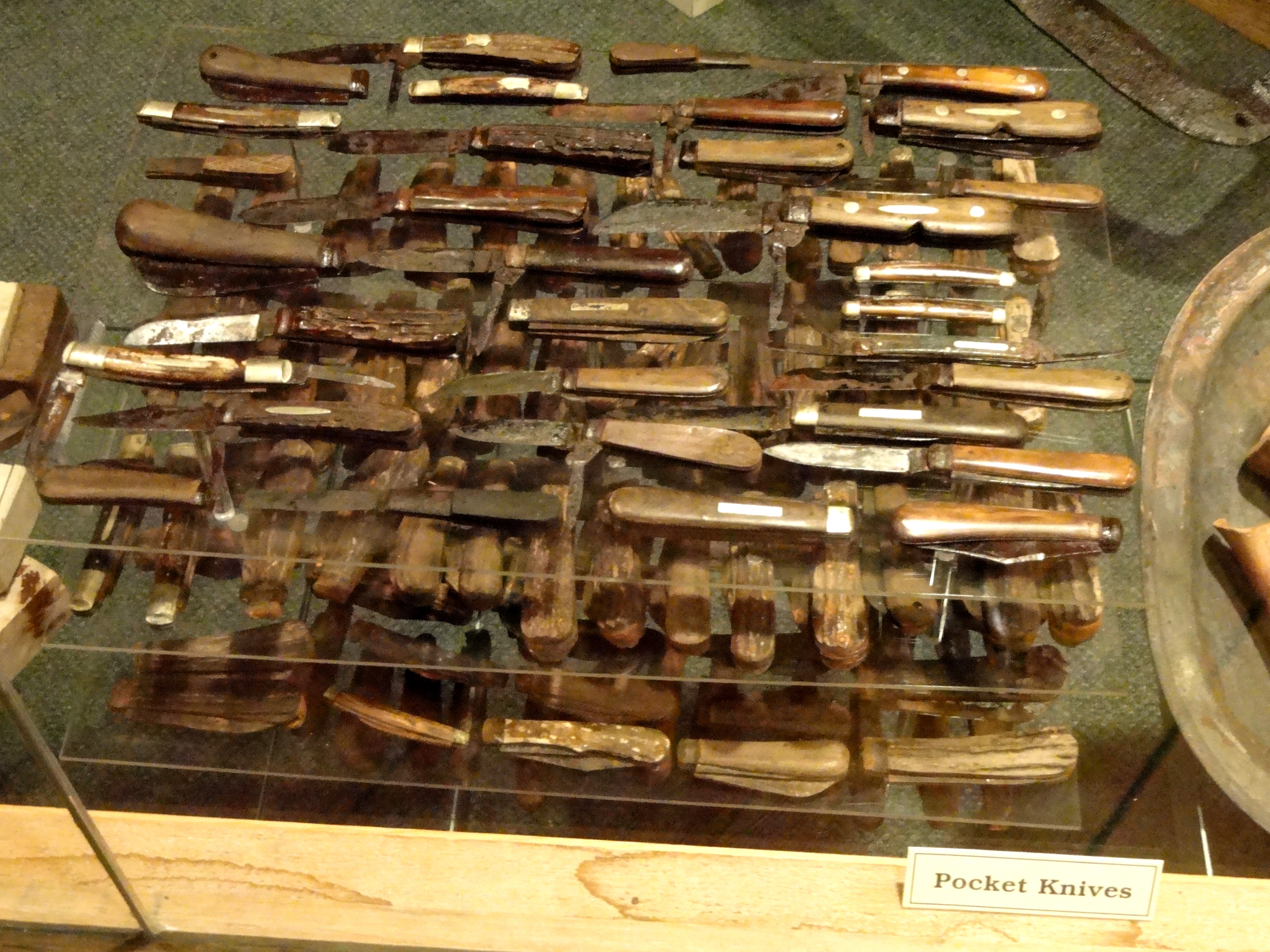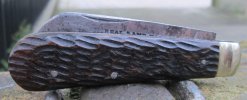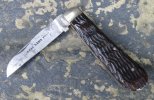- Joined
- Dec 2, 2005
- Messages
- 65,500
Here's a couple more pics of the knives from the Arabia 




Last edited:


I wonder if I could get a grant to study those knives and explore their capabilities.
Please welcome Mr. Bufhorn and Mr. Snakewood to the family!



I ALWAYS love looking at those photos of those Knives that went down - was it the Mississippi? What a stunning mass of Quality Knives that was lost!! Oh man...if one were to have those in their original condition it would be a world leader of a collection! Such a vast array of types of stunning variations of those knives - was this a shipment of Sheffield or USA made knives- a lot look like Sheffield.
Please welcome Mr. Bufhorn and Mr. Snakewood to the family!


If you're ever in Kansas City, the knives taken from the Arabia are on display in the museum there - http://1856.com/arabias-story/the-arabia-museum/
Those are two great scans, can I ask what the dates are? You are quite right about the blades, extremely interesting. Both beautiful knives too :thumbup:

Nice one AT and Troy, good to see you here.
I'm constantly amazed at both the depth of knowledge, and the generosity of spirit shown here on the Porch.
That treasure hoard of pocket cutlery from the Arabia is an amazing snapshot in time. I spend ages poring over it every time I see it.
The west coast of Victoria is known as the Shipwreck Coast, and over 600 mostly British ships from the days of sail, have their final resting place there.
I've made a few road trips out that way to examine the maritime museums and local historical societies for salvaged pocketknives on display, and have made some interesting finds, but no identifiable Lambsfoots, I'm afraid - at least in those exhibits from the 1870s. After a hundred years in salt water their condition is nothing like the Arabia hoard, but viewing the surviving pieces has given me absolute confidence in the durability of both sambar stag antler and ebony as handle materials.
https://en.m.wikipedia.org/wiki/Shipwreck_Coast
https://en.m.wikipedia.org/wiki/Loch_Ard_(ship)
But that's something for another post or thread - I'd better let us get back to Lambsfoots, before I get into trouble!
One last recommendation AT and Troy - there's some really great reading in this series if you haven't already seen it (those threads should really be stickied IMHO) -
http://www.bladeforums.com/forums/showthread.php/1229530-The-Dairy-Maids-of-Porter-Brook-(Part-1)
Here's a couple more pics of the knives from the Arabia :thumbup:


Here's a couple more pics of the knives from the Arabia :thumbup:
It's simply amazing how well they have survived!!! Thanks for the additional pictures.
Thanks Jack, I didn't know they were on display, should we meet there this weekend to study them?
The date for the Rodgers catalog is c. 1895, and the Taylor catalog is c. 1928.


It's simply amazing how well they have survived!!! Thanks for the additional pictures.
Seconded. Absolutely amazing artifacts. Thank you for sharing the extra photos.




It's interesting that the Lambsfoot is so widespread among traditional knife users here, having been like that at least since I was a boy. I'd have to check with Wright's, but bearing in mind how many different varieties of Lambsfoot they make, compared to clips or spears for example, it would seem to be their best-selling pattern. They tell me they mainly sell to farmers, and certainly if I go into agricultural areas, it is the knife I see stocked in hardware stores and feed-supply shops, often to the exclusion of all other patterns.
Thanks Jack and it feels good to participate at some level again.
That is such a fantastic picture of the group of knives from the Arabia ship and I have often thought about how incredible it would be to be able to inspect those knives in person. The picture is almost a tease.
With so many different knives, patterns, and blades, it sure makes it difficult sometimes to precisely quantify some models to an exact designation. Some are fairly obvious, but many sure seem to fall into that old gray zone. The Lamb Foot and Sheep foot blades appear (to me at least) to blur the lines some what. It also appears that time and different makers put their own spin on what a model or blade should look like. I agree that most of the Sheep foot blades run straight or parallel, and that most of the Lamb Foot blades run at a taper, but these rules seem to bend with the wind as well. Enclosed are two Sheffield examples, A Sheep Foot from Rodgers, and a Lamb Foot from Taylor. The Sheep foot blade has a slight taper, while the Lamb Foot blade runs nearly straight, go figure.
Regardless, I have sure enjoyed this thread and all the nuances involved.

Thanks Jack and it feels good to participate at some level again.
That is such a fantastic picture of the group of knives from the Arabia ship and I have often thought about how incredible it would be to be able to inspect those knives in person. The picture is almost a tease.
With so many different knives, patterns, and blades, it sure makes it difficult sometimes to precisely quantify some models to an exact designation. Some are fairly obvious, but many sure seem to fall into that old gray zone. The Lamb Foot and Sheep foot blades appear (to me at least) to blur the lines some what. It also appears that time and different makers put their own spin on what a model or blade should look like. I agree that most of the Sheep foot blades run straight or parallel, and that most of the Lamb Foot blades run at a taper, but these rules seem to bend with the wind as well. Enclosed are two Sheffield examples, A Sheep Foot from Rodgers, and a Lamb Foot from Taylor. The Sheep foot blade has a slight taper, while the Lamb Foot blade runs nearly straight, go figure.
Regardless, I have sure enjoyed this thread and all the nuances involved.

Seconded. Absolutely amazing artifacts. Thank you for sharing the extra photos.
Wouldn't that be great?
:thumbup:
Thanks for the catalogue dates, I had wondered if the parallel-bladed Taylor's Lambsfoot was an earlier model, but there's another theory out of the window!Daying the genesis of this pattern is proving tricky
:thumbup:
A pleasure :thumbup:
Carrying this Unity Lambsfoot todayHave a great weekend Guardians!
:thumbup:

This fascinates me. It appears that the Lambsfoot went from conception to near ubiquity in the British agrarian market relatively quickly. Perhaps in less than 100 years. Maybe less?
I could be wrong, but I assume that, during the time of the Lambsfoot's spread in popularity, most farmers limited their pocket knife purchases to replacements for their worn-out knives or as the first knife for a child as they came of age to do real work on the farm. So, it's not like the new Taylor's Eye Witness catalog for 18xx showed up in the mail one day, everyone said "oh, that looks nice", and then had one in their pocket a few weeks later.
I wonder what started the trend of opting for a Lambsfoot. Were its merits recognizable to old hands when they saw it at the general store and they decided to give it a try? Was it word of mouth and evangelism from neighbors that had been early adopters? Was there a Taylor's Eye Witness salesman making the rounds extolling the new pattern? All of the above? Something else entirely?
I don't know that these questions are any more answerable than when the Lambsfoot was first created, but I'm finding them fun to ponder.
These two interpretations really captivate me, the sleekness and yet simplicity. The bolsters are particularly impressive, small and very nicely worked.
Quality copies of these as an SFO would generate adulation......
